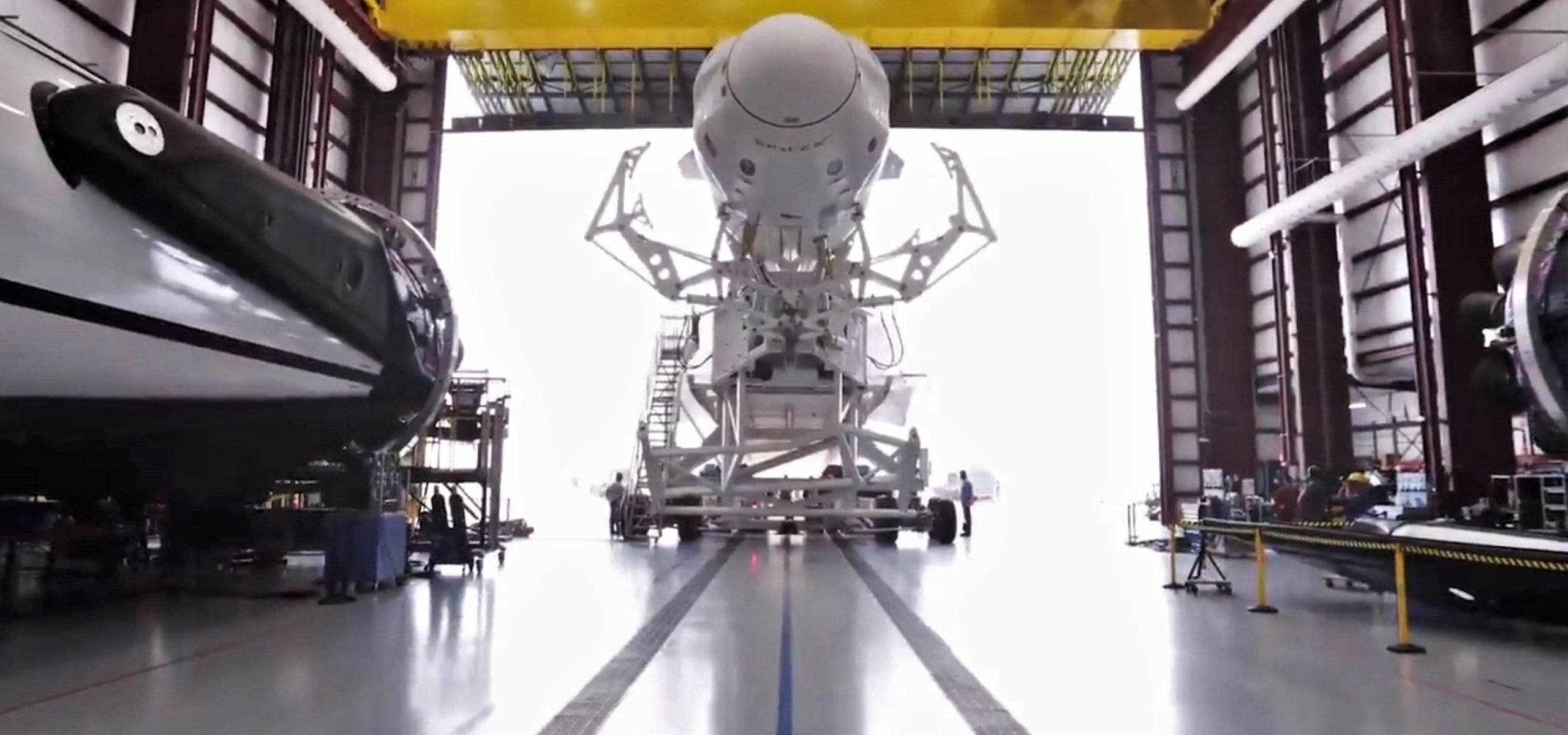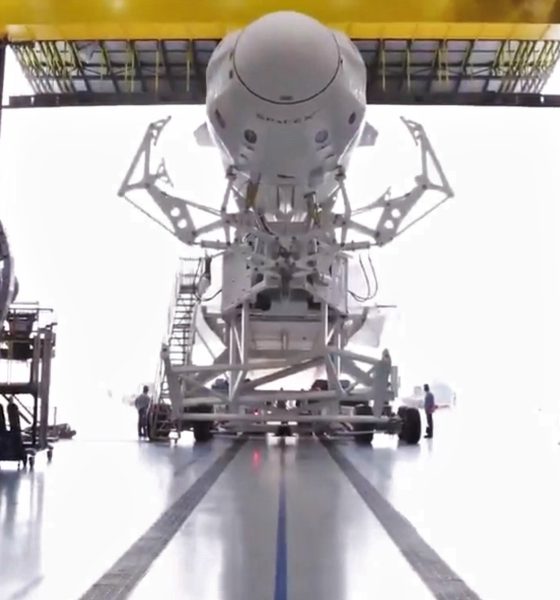

SpaceX
SpaceX hangar packed with Falcon Heavy Block 5 boosters for early April debut
For a company that rarely reveals anything without explicit intent, a February 28th video posted by SpaceX during the lead-up to Crew Dragon’s launch debut featured a surprise cameo: two Block 5 side boosters meant to support Falcon Heavy’s commercial debut and second launch ever.
Likely a subtle nod to close observers and fans, the inclusion of Falcon Heavy is a perfect bit of foreshadowing for the next launch set to occur from Pad 39A after Crew Dragon’s flawless orbital debut. As of now, Falcon Heavy Flight 2 is settling in on a potential launch as early as the first week of April, although delays during the rocket’s critical preflight processing and static fire test are about as likely as they were during the vehicle’s inaugural mission. If the rocket’s first launch and booster recoveries are fully successful, both side boosters (and perhaps the center core) could fly for a second time as few as two months later in June 2019.
A number of photos taken by Instagram users visiting Kennedy Space Center appear to indicate that SpaceX has more or less completed the reconfiguration of Pad 39A’s transporter/erector (T/E), modifying the base with additional hold-down clamps to account for three Falcon boosters instead of the usual one. Ten days after the successful launch of Falcon 9 B1051 in support of Crew Dragon’s first mission to orbit, it’s likely that additional work remains to ensure that 39A is fully refurbished and reconfigured for Falcon Heavy.
For the heavy-lift rocket’s commercial debut and second flight ever, SpaceX is likely to be exceptionally cautious and methodical in their preflight preparations. This is especially necessary due to the fact that Falcon Heavy Flight 2 differs dramatically from Falcon Heavy’s demo configuration, degrading the applicability of some aspects of the data gathered during the rocket’s largely successful test flight.
Most notably, all three first stage boosters will be Block 5 variants on their first flights, whereas Flight 1’s first stage featured two flight-proven Block 2 boosters (B1023 and B1025) and one new Block 3 booster (B1033). Additionally, the center core – B1033 – was lost during a landing anomaly that prevented the booster from reigniting its engine for a landing burn, cutting off another valuable source of data that would have served to better inform engineers on the performance of Falcon Heavy’s complex and previously unproven mechanical stage separation mechanisms.

Falcon 9 Block 5 is a fairly radical departure from the Block 2 and 3 variants SpaceX based Falcon Heavy’s initial design on. It’s possible that the rocket’s engineers were able to at least set up that design and manufacturing work on a safe path to forward compatibility, but it’s equally possible that so much work was focused on simply getting the vehicle past its launch debut that compatibility with Falcon 9 Block 4 and 5 was pushed well into the periphery. Considering the fact that it has now been more than a year since Falcon Heavy’s February 6th, 2018 debut, the latter eventuality offers a much better fit. Nevertheless, with a solid 13-14 additional months of redesign and testing complete, it seems that SpaceX is keen to get its super heavy-lift launch vehicle back on the horse, so to speak.
The specific changes made in Falcon 9 Block 4 is unclear aside from a general improvement in Merlin 1D and MVac performance, as well as significant upgrades to Falcon 9’s upper stage, likely focused on US military and NASA requirements for long-coast capabilities on unique mission profiles. Most significantly, Falcon 9 Block 5 transitioned the SpaceX rocket to a radically different primary thrust structure (also known as the octaweb), replacing welded assemblies with bolted assemblies wherever possible. This simultaneously allows for easier repairs and modifications, improves ease of manufacture, and increases the structure’s overall strength, a critical benefit for Falcon Heavy’s heavily-stressed center core. Meanwhile, Falcon 9 Block 5 moved from Full Thrust’s (Block 3/4) maximum 6800 kN (1,530,000 lbf) of thrust to more than 7600 kN (1,710,000 lbf), an increase of roughly 12%. Combined with Block 5’s focus on extreme reusability, SpaceX engineers and technicians likely had to do a huge amount of work to leap from Falcon Heavy Flight 1 to Flight 2.

Aside from the presence of both Falcon Heavy side boosters, both of which were spotted arriving in Florida by local observers, the first Block 5 Falcon Heavy center core also very likely arrived within the last few months, followed rapidly by can be assumed to be the mission’s fairing and Falcon upper stage. Falcon Heavy’s commercial debut will see the rocket attempt to place communications satellite Arabsat 6A – weighing around 6000 kg (13,200 lb) – into a high-energy geostationary orbit, either direct-to-GEO or a transfer (GTO) variety.
If all goes according to plan, SpaceX will attempt to turn around Falcon Heavy’s Block 5 side boosters (B1052 and B1053) for Falcon Heavy’s third launch – the USAF’s STP-2 mission – as few as 60-80 days later, June 2019. According to NASASpaceflight, STP-2 will fly with a new center core (presumed to be B1057) instead of reusing Arabsat 6A’s well-cooked B1055 booster.
Check out Teslarati’s Marketplace! We offer Tesla accessories, including for the Tesla Cybertruck and Tesla Model 3.

Elon Musk
Elon Musk’s Biggest Revelations on AI, Robots, and the Future of Work from the Moonshots Podcast

Elon Musk’s appearance on the Moonshots with Peter Diamandis podcast was packed with bold predictions, candid admissions, and surprising tech insights. The nearly three-hour conversation covered everything from artificial intelligence to humanoid robots, geopolitics, and the future of work. Here are the top 10 most intriguing takeaways:
-
Aggressive AGI Timeline Predictions
Musk offered a detailed view on when artificial general intelligence (AGI) could emerge, suggesting it may arrive sooner than many expect, emphasizing both transformative potential and risks.
-
U.S. vs. China in the AI Race
He discussed the strategic competition between the United States and China over AI development, noting that geopolitical dynamics will shape how and who leads in the next decades.
-
Future of Job Markets
Musk touched on how AI and automation could reshape employment, predicting massive boosts in productivity alongside potential disruptions in traditional work structures.
-
Clean Energy Transition
A recurring theme was the role of clean energy in future economies, with Musk reiterating the importance of scaling sustainable power generation and storage.
-
Humanoid Robots Are Coming
On the podcast, Musk elaborated on Tesla’s work on humanoid robots, hinting at timelines and applications that go beyond factories to general-purpose assistance.
-
Tesla Roadster “Last Human-Driven Car”
Outside the core discussion topics, Musk teased features of the upcoming Tesla Roadster — calling it “the best of the last of the human-driven cars” and suggesting safety won’t be its main selling point.
-
The Role of AI in Clean Energy and Robotics
Linking AI to both energy optimization and robotics, Musk explained how smarter systems could accelerate decarbonization and task automation across industries.
-
U.S. Innovation Leadership
Musk argued that maintaining American leadership in key tech sectors like AI, space, and robotics should be a national priority, with thoughtful policy and investment.
-
Job Creation vs. Job Elimination
While acknowledging automation’s disruptive effects, he also outlined scenarios where new industries and opportunities could emerge, particularly in AI, space, and advanced manufacturing.
-
Long-Term Vision for Humanity
Throughout the conversation, Musk revisited his long-term philosophical views — including a belief in humanity’s responsibility to become a multi-planetary and technologically empowered species.
Whether you agree with Musk’s optimism or not, the podcast offers a window into the thinking of one of the most influential figures in tech today, in and why his visions continue to spark debate and inspiration.
Elon Musk
Starlink achieves major milestones in 2025 progress report
Starlink wrapped up 2025 with impressive growth, adding more than 4.6 million new active customers and expanding service to 35 additional countries, territories, and markets.

Starlink wrapped up 2025 with impressive growth, adding more than 4.6 million new active customers and expanding service to 35 additional countries, territories, and markets. The company also completed deployment of its first-generation Direct to Cell constellation, launching over 650 satellites in just 18 months to enable cellular connectivity.
SpaceX highlighted Starlink’s impressive 2025 progress in an extensive report.
Key achievements from Starlink’s 2025 Progress
Starlink connected over 4.6 million new customers with high-speed internet while bringing service to 35 more regions worldwide in 2025. Starlink is now connecting 9.2 million people worldwide. The service achieved this just weeks after hitting its 8 million customer milestone.
Starlink is now available in 155 markets, including areas that are unreachable by traditional ISPs. As per SpaceX, Starlink has also provided over 21 million airline passengers and 20 million cruise passengers with reliable high-speed internet connectivity during their travels.
Starlink Direct to Cell
Starlink’s Direct to Cell constellation, more than 650 satellites strong, has already connected over 12 million people at least once, marking a breakthrough in global mobile coverage.
Starlink Direct to Cell is currently rolled out to 22 countries and 6 continents, with over 6 million monthly customers. Starlink Direct to Cell also has 27 MNO partners to date.
“This year, SpaceX completed deployment of the first generation of the Starlink Direct to Cell constellation, with more than 650 satellites launched to low-Earth orbit in just 18 months. Starlink Direct to Cell has connected more than 12 million people, and counting, at least once, providing life-saving connectivity when people need it most,” SpaceX wrote.
Elon Musk
Starlink passes 9 million active customers just weeks after hitting 8 million
The milestone highlights the accelerating growth of Starlink, which has now been adding over 20,000 new users per day.

SpaceX’s Starlink satellite internet service has continued its rapid global expansion, surpassing 9 million active customers just weeks after crossing the 8 million mark.
The milestone highlights the accelerating growth of Starlink, which has now been adding over 20,000 new users per day.
9 million customers
In a post on X, SpaceX stated that Starlink now serves over 9 million active users across 155 countries, territories, and markets. The company reached 8 million customers in early November, meaning it added roughly 1 million subscribers in under seven weeks, or about 21,275 new users on average per day.
“Starlink is connecting more than 9M active customers with high-speed internet across 155 countries, territories, and many other markets,” Starlink wrote in a post on its official X account. SpaceX President Gwynne Shotwell also celebrated the milestone on X. “A huge thank you to all of our customers and congrats to the Starlink team for such an incredible product,” she wrote.
That growth rate reflects both rising demand for broadband in underserved regions and Starlink’s expanding satellite constellation, which now includes more than 9,000 low-Earth-orbit satellites designed to deliver high-speed, low-latency internet worldwide.
Starlink’s momentum
Starlink’s momentum has been building up. SpaceX reported 4.6 million Starlink customers in December 2024, followed by 7 million by August 2025, and 8 million customers in November. Independent data also suggests Starlink usage is rising sharply, with Cloudflare reporting that global web traffic from Starlink users more than doubled in 2025, as noted in an Insider report.
Starlink’s momentum is increasingly tied to SpaceX’s broader financial outlook. Elon Musk has said the satellite network is “by far” the company’s largest revenue driver, and reports suggest SpaceX may be positioning itself for an initial public offering as soon as next year, with valuations estimated as high as $1.5 trillion. Musk has also suggested in the past that Starlink could have its own IPO in the future.








